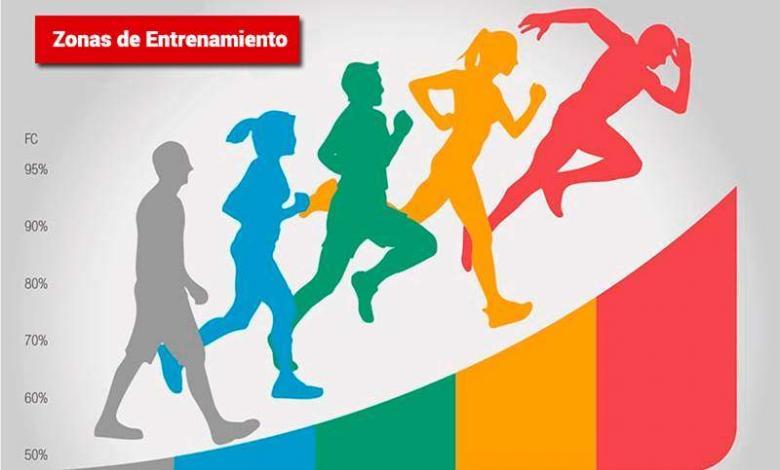What are training zones?
Depending on the working heart rate, we will differentiate 5 training zones

If you want to improve, it is not worth simply training, you have to train well. And for that you should know that different intensities mark a work zone and they affect the body in a different way.
The training areas or work are determined based on the intensity that may be expressed by heart rate or by other parameters such as oxygen consumption.
According to heart rate dand we are going to differentiate you 5 training zones and its repercussions on the organism:
| % HR | PE | |
| 1 Zone | <65% | 2 |
| 2 Zone | 65- 80% | 3 – 4 |
| 3 Zone | 80-85% | 7 |
| 4 Zone | 85-90% | 8 – 9 |
| 5 Zone | > 95% | 10 |
% HR, percentage of heart rate, PE: Perception of effort, scale of 10
Zone 1.
It assumes a lower intensity of 65% of your maximum HR. In this area we work in warm ups, back to calm and recoveries between series, so its function in the body is to recover or prepare.
It should give you a feeling of effort of 2 out of 10.
Zone 2.
The intensity ranges from 65 and 80% of the maximum HR. You can associate this intensity with long shooting pace and comfortable, where you can go chatting with a partner. The work in this area improve aerobic endurance as well as the oxidation of fats.
It should give you a feeling of effort of 3-4 out of 10
Zone 3.
The intensity is between the 80-85% of the maximum HR. It is a job that requires concentration to maintain the effort, but that effort is relatively bearable.
Improves the use of glycogen and its deposits and involves an increase in parameters such as hemoglobin, cardiac output and systolic volume in the body.
The feeling of effort is 7 out of 10
Zone 4.
The intensity is of 85 to 90% of maximum HR. It is a high work effort which causes a lot of fatigue, which causes an improvement in the ability to withstand effort in conditions close to maximum oxygen consumption.
His feeling of effort is 8-9 out of 10.
Zone 5.
The intensity can be said to be maximum, > 95% of maximum HR. It is the one we use to perform Series of shorter distance but with a very high or maximum speed
Workouts in this area are used to improve lactate tolerance, increase glycolytic capacity and improve energy supply through anaerobic anaerobic glycolysis.
It implies a perception of maximum effort.
Ideally to calculate them, the stress test
Nowadays it is easy to estimate your training zones thanks to the clocks, however for higher level athletes it is advisable to perform stress tests with the appropriate means to the specific sport to calculate said training intervals.
Knowing the intensity of training at each moment of the season and planning it according to its objectives, is a job that will be more beneficial if you have the supervision of qualified trainers.
Laura García Cervantes

There are no previous results.




























